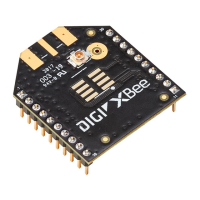Update the firmware Update the device firmware
Digi XBee® 3 Cellular LTE Cat 1 AT&T Smart Modem User Guide
91
ii. Add bitwise-AND with 0x3FFF.
(0xDB8A + 0x123456) & 0x3FFF= 0x0FE0
iii. Send the command AT%PFE0.
AT%PFE0
b. The OK string is returned.
c. After the command is sent, the radio module resets and automatically enters
programming mode.
d. Send the FRcommand to reboot and enter into bootloader.
n Invoke the bootloader with hardware signaling
a. De-Assert RTS (pin 16).
b. Assert DTR (pin 9).
c. Put DIN in a low state (break) (pin 3).
d. Reset the module (pin 5).
e. Release the break on DIN (pin 3) The module should now be in bootloader at 38400
baud.
3. Once the module is in programming (bootloader) mode, configure the local serial port to
38400/8/N/1.
4. Get the hardware version of the radio module from the bootloader.
a. Send the V command. The response to that command has the following format:
XXXXYYYYZZAABBBBCCCCCCCCCCCCCCCC
n XXXX: The hardware version.
See ATHV, little endian.
n YYYY: The hardware revision.
See AT%R, little endian.
n ZZ: The hardware compatibility
number. See AT%C.
n AA: Unused and should be 0.
n BBBB: The hardware series. See
ATHS, little endian.
n CCCCCCCCCCCCCCCC: The
serial number.
5. If possible, change the baud rate of the serial port to optimize the firmware update process.
Send the X command to the bootloader.
n The bootloader answers with the maximum supported baud rate (in ASCII) and, just
after that, the bootloader changes its baud rate to that value. Change your baud rate to
match the max supported rate.
n If the bootloader does not answer to this command, remain at the current rate.
6. Send the I command (initialization command). This command erases the current firmware from
the device.

